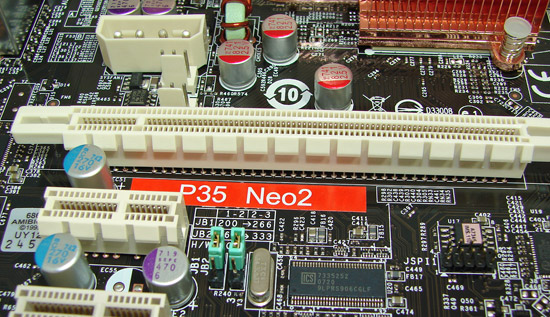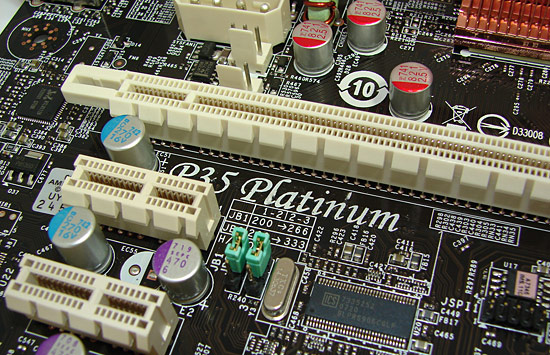MSI P35 Neo2-FR: Platinum performance for under $100
by Gary Key on December 5, 2007 11:00 PM EST- Posted in
- Motherboards
We have not heard that much from MSI lately. Yes, they always seem to launch product at the same time as ASUS and Gigabyte, but their product launches always seem subdued. Their marketing program does not usually have the all-out blitz we typically see from ASUS or Gigabyte, or their product lineup may lack a killer feature. We know MSI is there - in fact, not a day goes by without us discussing products or technology with them - so what's the problem? It comes down to having a product design or feature that differentiates MSI from the other suppliers. No, we are not talking about roller coaster designed heatpipes; we are talking about product that outperforms the competition at launch or can make a difference in how you use or perceive the value of the product.
We have seen a great deal of improvement in MSI's motherboard products over the course of the last year. Their layouts have improved and in fact, we absolutely love the layout on the new K9A2 Platinum board that uses AMD's new 790FX chipset. MSI also offers the Creative Lab's X-Fi audio codecs on their high-end boards as a nod to the gaming community. In addition to unique layouts or features, their overall product quality and commitment to performance has been steadily improving. Our problem with MSI the past few product launches has not centered on them being late to market or not having compelling product alternatives. It has come down to basic performance, compatibility, and BIOS features that leave a lot to be desired when comparing them to the likes of ASUS or Gigabyte. We witnessed this with the P35 launch last spring and again with the 790FX a couple of weeks ago. Their boards are solid and perform well at launch; only the BIOS releases have been weak. The difference we are seeing now is that MSI is quickly resolving problems, and they continue to provide support and updates over the lifespan of the product.


Identical or Fraternal Twins?
The other difference is that MSI is starting to offer a compelling value in certain market segments. One such market segment is the quickly growing budget performance sector, which is now moving to Intel's P35 chipset. The initial launch of the P35 chipset featured boards in the $200 and up price grouping from ASUS, Gigabyte, and MSI. MSI's offering, the P35 Platinum, was at the low end of this sector but did not offer a very good price to performance ratio when compared to the other boards. This changed greatly a few weeks after its release with the P3 performance-oriented BIOS. However, there was an eerie silence at the time as abit had just introduced the similarly priced and very impressive IP35-Pro to a thunderous roar from the user community.
With the introduction of the X38 chipset and the widespread adoption of P35 across a variety of products, we are now seeing incredible competition in the budget to midrange markets. As competition has increased, prices have decreased and the selection of performance-oriented motherboards for under a $130 is incredible. We say this considering the typical prices that usually accompany Intel chipsets. What is even more amazing is the level of performance and features that a user can purchase for under $100 now. We are not talking about the P965 or 945P based boards, but boards designed around the P35 chipset.
MSI offers a base P35 board for around $72, but that board like other budget designs is suited for SOHO users. What excites us in the under $100 performance market are boards like the abit IP35-E and Gigabyte GA-P35-DS3L. Recognizing this trend, MSI developed the Neo2 series. In actuality, they did not have to do too much development; the Neo2-FR/FIR is just a rebadged P35 Platinum with a couple of features missing. MSI is not really hiding this fact; the user can easily remove the Neo2 label to see the Platinum silk screen. The features missing are not extensive either; the FR board drops FireWire and an S/PDIF Optical out port while the FIR is only missing the Optical out port.
Fortunately, for us the performance remains the same, as does the support, features, and quality. The only difference is the almost $40 reduction in price, something we can all use. Let's look at the MSI Neo2-FR feature set and performance results. Our findings might just make you sit up and take notice of MSI again.










35 Comments
View All Comments
DigitalFreak - Thursday, December 6, 2007 - link
I sincerely hope that the USB port block on the back is supported by more than just that tiny riser. That thing looks like it would break off if you looked at it funny.Griswold - Thursday, December 6, 2007 - link
Nothing to worry about, unless some clumsy fool or 8 year old child rams the USB plug in.superkdogg - Thursday, December 6, 2007 - link
Reading the introduction about the surprising performance of the new MSI board got my ears up, but then I read the article and it was more of the same.Every motherboard performs virtually the same these days at stock speeds. The only things that differentiate anything is overclocking/bios, reliability, layout, price, extra features (if you need them), and personal brand preference.
Motherboard 'reviews' could pretty much be replaced by a table that tells a consumer about those things above. Benchmarking showing that everything is +/- 2% from the median just eats up space.
j@cko - Thursday, December 6, 2007 - link
LOL. I totally agree with ya. Motherboard review nowadays is more about reliability and overclockability, I think.JarredWalton - Thursday, December 6, 2007 - link
The problem is, if we were to eliminate all of the benchmarking, how do we really know if a board is reliable? If you haven't noticed, 90% or something of the text on the benchmark pages is filler - the graphs pretty much say everything you need to know. Anyway, doing motherboard reviews can be a thankless endeavor, but we still think it's necessary. We're not quite at the "necessary evil" stage either. :)brian_riendeau - Thursday, December 6, 2007 - link
Its quite easy really to show the effectiveness of a mobo design without wasting 5 pages on graphs that show no difference between 10 models of motherboards.Test the motherboards in harsh environments. No one really cares if their board is 1% faster than another board, however they will care if their whole system crashes repeatedly if their AC goes out and the room temp gets up to 90F.
drebo - Thursday, December 6, 2007 - link
Death of the P35 Neo-F, one of the best mid-range boards ever made. For $85 you get a superb P35 board, but they're not making it anymore. Moving to this board, you lose Parallel and Serial ports, which for many general home users are very important.Intel doesn't make a P35 board with parallel or serial, and ASUS's P5K board is about $40 more expensive. I really wish a tier 1 manufacturer would come out with another good board. The last couple generations it's been MSI, with the P965 Neo3-F and then the P35 Neo-F. Looks as though there won't be a P35 Neo2-F, unfortunately. They're making a hybrid DDR2/DDR3 board instead, which neuters any kind of RAM upgrades for the end users because you can only use one or the other, not both, and neither in a dual-channel configuration.
Oh well. Maybe ASUS will drop the price of their P5K board.
Ratinator - Thursday, December 6, 2007 - link
[quote]Moving to this board, you lose Parallel and Serial ports, which for many general home users are very important. [/quote]Did you mean not very important?
drebo - Thursday, December 6, 2007 - link
No, I didn't. You'd be surprised how many people at home have serial mice they don't want to replace (old trackballs that they're too stubborn to get rid of) and parallel printers. A lot of people in the business world need them, too. They need parallel for printers and serial to run machines off of, or for their PDAs, or for other reasons.There needs to be a good midrange board that still supports these legacy devices, and with the P35 Neo-F going by the wayside, that board just doesn't exist anymore.
brian_riendeau - Thursday, December 6, 2007 - link
I am sorry to inform you of this, however not many people shopping for new motherboards for business or personal use care about serial and parallel ports. You just gotta let things go man... Anyone who really needs to use a legacy port can pickup USB port -> legacy port adapters for cheap if they really need to use old hardware. We have a whole department of people where I work still chained to serial devices, however they all have C2D and Quad core PCs now and just use USB adapters.